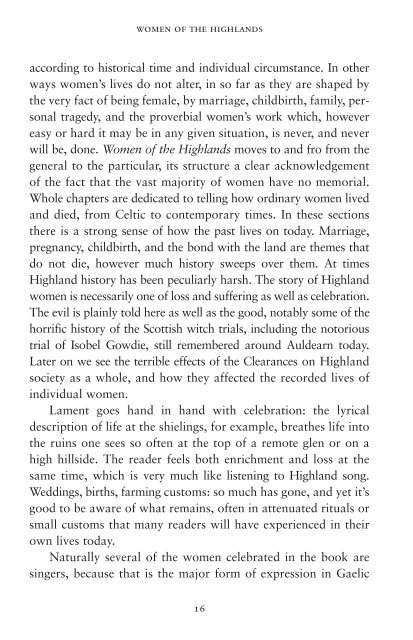Women of the Highlands by Katharine Stewart sampler
What was the crime of the last wich burnt in the Highlands? Which Jacobite lady led men to war while her Hanoverian husband stayed at home? Who were the first Highland women to be recorded in history? And how have wome's lives changed since medieval times? Katharine Stewart takes us to the heart of the Highlands in her history of the women who shaped this land and handed down the legends which have provided a rich vein of material for generations. From the women of the shielings to ladies at court, from bards to conservationists, authors to folk-singers, Women of the Highlands examines how the culture of the Highlands was created and passed down through the centuries, and how the tradition is continuing today.
What was the crime of the last wich burnt in the Highlands?
Which Jacobite lady led men to war while her Hanoverian husband stayed at home?
Who were the first Highland women to be recorded in history?
And how have wome's lives changed since medieval times?
Katharine Stewart takes us to the heart of the Highlands in her history of the women who shaped this land and handed down the legends which have provided a rich vein of material for generations. From the women of the shielings to ladies at court, from bards to conservationists, authors to folk-singers, Women of the Highlands examines how the culture of the Highlands was created and passed down through the centuries, and how the tradition is continuing today.
Create successful ePaper yourself
Turn your PDF publications into a flip-book with our unique Google optimized e-Paper software.
women <strong>of</strong> <strong>the</strong> highlands<br />
according to historical time and individual circumstance. In o<strong>the</strong>r<br />
ways women’s lives do not alter, in so far as <strong>the</strong>y are shaped <strong>by</strong><br />
<strong>the</strong> very fact <strong>of</strong> being female, <strong>by</strong> marriage, childbirth, family, personal<br />
tragedy, and <strong>the</strong> proverbial women’s work which, however<br />
easy or hard it may be in any given situation, is never, and never<br />
will be, done. <strong>Women</strong> <strong>of</strong> <strong>the</strong> <strong>Highlands</strong> moves to and fro from <strong>the</strong><br />
general to <strong>the</strong> particular, its structure a clear acknowledgement<br />
<strong>of</strong> <strong>the</strong> fact that <strong>the</strong> vast majority <strong>of</strong> women have no memorial.<br />
Whole chapters are dedicated to telling how ordinary women lived<br />
and died, from Celtic to contemporary times. In <strong>the</strong>se sections<br />
<strong>the</strong>re is a strong sense <strong>of</strong> how <strong>the</strong> past lives on today. Marriage,<br />
pregnancy, childbirth, and <strong>the</strong> bond with <strong>the</strong> land are <strong>the</strong>mes that<br />
do not die, however much history sweeps over <strong>the</strong>m. At times<br />
Highland history has been peculiarly harsh. The story <strong>of</strong> Highland<br />
women is necessarily one <strong>of</strong> loss and suffering as well as celebration.<br />
The evil is plainly told here as well as <strong>the</strong> good, notably some <strong>of</strong> <strong>the</strong><br />
horrific history <strong>of</strong> <strong>the</strong> Scottish witch trials, including <strong>the</strong> notorious<br />
trial <strong>of</strong> Isobel Gowdie, still remembered around Auldearn today.<br />
Later on we see <strong>the</strong> terrible effects <strong>of</strong> <strong>the</strong> Clearances on Highland<br />
society as a whole, and how <strong>the</strong>y affected <strong>the</strong> recorded lives <strong>of</strong><br />
individual women.<br />
Lament goes hand in hand with celebration: <strong>the</strong> lyrical<br />
description <strong>of</strong> life at <strong>the</strong> shielings, for example, brea<strong>the</strong>s life into<br />
<strong>the</strong> ruins one sees so <strong>of</strong>ten at <strong>the</strong> top <strong>of</strong> a remote glen or on a<br />
high hillside. The reader feels both enrichment and loss at <strong>the</strong><br />
same time, which is very much like listening to Highland song.<br />
Weddings, births, farming customs: so much has gone, and yet it’s<br />
good to be aware <strong>of</strong> what remains, <strong>of</strong>ten in attenuated rituals or<br />
small customs that many readers will have experienced in <strong>the</strong>ir<br />
own lives today.<br />
Naturally several <strong>of</strong> <strong>the</strong> women celebrated in <strong>the</strong> book are<br />
singers, because that is <strong>the</strong> major form <strong>of</strong> expression in Gaelic<br />
16


















